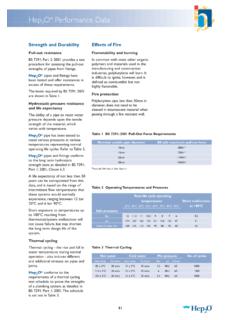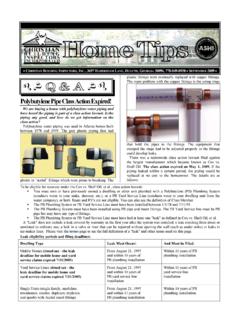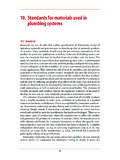Transcription of Rule of Thumb Tonnage, Shrink & Vent Depth Values
1 Rule of Thumb Tonnage, Shrink & Vent Depth Values The following table consists of tonnage requirements, vent depths and range of shrinkage suggested by material suppliers and the rules of Thumb that we typically use. Part geometry is a major consideration and can play an important part in determining the necessary Values to be used. All materials should be researched through material suppliers and technical service for the actual Values to use. Rule of Thumb Shrink Vent Material Tons per in2 Values Depth (in.) Acrylonitrile Butadiene Styrene (ABS) .004 - .008 .0010 - .0020 ABS/Polycarbonate Blend (PC/ABS) .004 - .007 .0015 - .0030 Acetal (POM) .020 - .035 .0005 - .0015 Acrylic (PMMA) .002 - .010 .0015 - .0020 Ethylene Vinyl Acetate (EVA) .010 - .030 .0005 - .0007 Ionomer.
2 003 - .020 .0005 - .0007 High Density Polyethylene (HDPE) .015 - .030 .0008 - .0010 Low Density Polyethylene (LDPE) .015 - .035 .0005 - .0007 Polyamide - Nylon (PA) Filled .005 - .010 .0003 - .0010 Polyamide - Nylon (PA) Unfilled .007 - .025 .0005 - .0020 Polybutylene Terephthalate (PBT) .008 - .010 .0005 - .0015 Polycarbonate (PC) .005 - .007 .0010 - .0030 Polyester .006 - .022 .0005 - .0010 Polyetheretherketone (PEEK) .010 - .020 .0005 - .0007 Polyetherimide (PEI) .005 - .007 .0010 - .0015 Polyethylene (PE) .015 - .035 .0005 - .0020 Polyethersulfone (PES) .002 - .007 .0005 - .0007 Polyphenylene Oxide (PPO) .005 - .007 .0010 - .0020 Polyphenylene Sulfide (PPS) .002 - .005 .0005 - .0010 Polyphthalamide (PPA).
3 005 - .007 .0005 - .0020 Polypropylene (PP) .010 - .030 .0005 - .0020 Polystyrene (PS) .002 - .008 .0015 - .0020 Polysulphone (PSU) .006 - .008 .0010 - .0015 Polyurethane (PUR) .010 - .020 .0004 - .0010 Polyvinyl Chloride (PVC) .002 - .030 .0005 - .0020 Thermoplastic Elastomer (TPE) .005 - .020 .0008 - .0010 When a part is being evaluated for clamp tonnage requirements, keep in mind that a thin wall part will need a higher amount of tonnage, while a thick wall part will be in the lower range. Tonnage is also dependant upon the cycle time of the mold.





